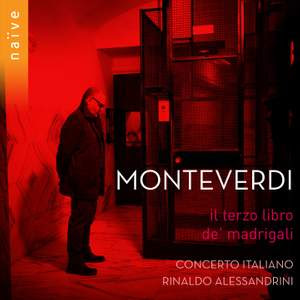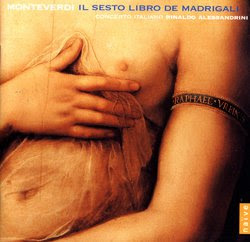Program: #21-31 Air Date: Jul 26, 2021
To listen to this show, you must first LOG IN. If you have already logged in, but you are still seeing this message, please SUBSCRIBE or UPGRADE your subscriber level today.
Considered perhaps the finest Monteverdi interpreter of our time, the Italian director of the Concerto Italiano guides us through madrigal books 3, 5 & 6.
I. Monteverdi: Il terzo libro de’madrigali. Naive CD OP 30580.

No one knows better than Rinaldo Alessandrini that Monteverdi’s madrigals - to which he has dedicated a major part of his work and recordings over the past thirty years - were above all texts where the music was the servant and not the mistress.
This form of a cappella vocal polyphony, responding sensitively to the inflections of a highly expressive poetry, was born in the full flowering of Renaissance humanism and developed in the 17th Century by composers such as Monteverdi, Marenzio and Gesualdo, before being supplanted by the opera.
As the Italian maestro explains, in the Third Book of Madrigals we can already see how carefully the twenty-five-year-old Monteverdi chooses poetry, by Guarini and Tasso, for example, which is capable of “responding to the needs of the drama, of truth, humanity and emotionality, culminating at the end of his life in the lustrous triumph of his final works.”
Put all the above ingredients into the mixer and you arrive at Monteverdi’s third book of madrigals, Il terzo libro de’ madrigali, published in 1592. For Guarini, whose erotic poetry provided the bulk of Monteverdi’s settings in Book 3, and the taste for the sensual combination of high voices established at Ferrara it is necessary to look no further than the delicate tapestry of the first half of the opening madrigal, ‘La giovinetta pianta’, the luminescent texture employed in talking of ‘the tender young plant’ perhaps less potent than in more serious texts but sensuous none the less. All the madrigals in Book 3 are scored for five voices, still of course a cappella at this point in the composer’s development. One of the remarkable features is the manner in which Monteverdi consistently alternates contrasts of colour between high and low voices and texture between polyphony and homophony, nearly always to dramatic purpose. These characteristics are well illustrated in the final madrigal of the collection, the two-part ‘Rimanti in pace’, to a text by Livio Celiano, a pen name for Angelo Grillo. The declamatory poem is part direct speech and part narrative, the composer clearly differentiating the two by giving the parting Tirso’s departing words to his Fillida, ‘Stay and peace be with you’, given to upper voices, while those narrated are darker and more homophonic. The brief cycle comes to a shattering conclusion with the reiteration of Fillida’s unbearably poignant motif, ‘Deh, cara anima mia’ (Tell me, dear heart of mine … who takes you from me?).
Such settings mark a foretaste of the innate dramatic gifts that would eventually lead to Monteverdi becoming the first great opera composer. They are even more in evidence in a pair of three-part cycles in which the text is drawn from episodes in Tasso’s Gerusalemme liberata, the first, ‘Vattene pur crudel’ describing the fury and then torment of Armida deserted by Rinaldo, the second the distress of the Christian knight Tancredi after he has killed the Saracen warrior-maiden Clorinda, a topic to which Monteverdi would return memorably in Book 8 almost fifty years later. The former, again a declamatory alternation of direct speech and narrative, the latter vividly descriptive at the point at the end of part 2, where Armida, faint from extreme emotion, lapses into unconsciousness as quiet dissonance takes over before the third part opens with a magical evocation of ‘nothing but empty silence all about her’ greets the reviving Armida.
The madrigal ensemble of Rinaldo Alessandrini’s Concerto Italiano has gone through several reincarnations since he first started recording Monteverdi’s madrigals. Indeed Alessandro reminds us in a booklet note that it is fifteen years since his last complete madrigal book recording (Book 6). The present ensemble is at least a match for any of its predecessors, with both individuality – the two leading sopranos, Francesca Cassinari and Monica Piccinini, have pleasingly differentiated voices – and an excellent blend that retains enough clarity to allow contrapuntal strands to stand out clearly. Diction and articulation, too, are excellent. Just once or twice I did wonder if Alessandrini was making a little too much of tempo contrasts (‘O primavera’ is an example), but such doubts are rapidly banished within the context of such exceptionally musical performances.
Brian Robins
- 1Il terzo libro de madrigali a cinque voci: "La giovinetta pianta” 03:16
- 2Il terzo libro de madrigali a cinque voci: "O come è gran martíre” 03:29
- 3Il terzo libro de madrigali a cinque voci: "Sovra tenere erbette e bianchi fiori” 03:08
- 4Il terzo libro de madrigali a cinque voci: "O dolce anima mia, dunque è pur vero” 03:55
- 5Il terzo libro de madrigali a cinque voci: "Stracciami pure il core” 03:28
- 6Il terzo libro de madrigali a cinque voci: "O rossignuol che in queste verdi fronde” 04:39
- 7Il terzo libro de madrigali a cinque voci: "Se per estremo ardore” 03:24
- 8Il terzo libro de madrigali a cinque voci: "Vattene pure, crudel. Vattene pure, crudel, con quella pace” 01:46
- 9Il terzo libro de madrigali a cinque voci: "Vattene pure, crudel. Là tra il sangue e le morti egro giacente [seconda parte]” 02:35
- 10Il terzo libro de madrigali a cinque voci: "Vattene pure, crudel. Poi ch’ella in sé tornò, deserto e muto [terza parte]” 03:45
- 11Il terzo libro de madrigali a cinque voci: "O primavera, gioventù dell’anno” 03:08
- 12Il terzo libro de madrigali a cinque voci: "Perfidissimo volto” 03:44
- 13Il terzo libro de madrigali a cinque voci: "Ch’io non t’ami, cor mio?” 04:22
- 14Il terzo libro de madrigali a cinque voci: "Occhi, un tempo mia vita” 03:14
- 15Il terzo libro de madrigali a cinque voci: "Vivrò fra i miei tormenti. Vivrò fra i miei tormenti e le mie cure [prima parte]” 01:15
- 16Il terzo libro de madrigali a cinque voci: "Vivrò fra i miei tormenti. ma dove, oh lasso me! [seconda parte]” 02:52
- 17Il terzo libro de madrigali a cinque voci: "Vivrò fra i miei tormenti. Io pur verrò là dove sete [terza parte]” 02:37
- 18Il terzo libro de madrigali a cinque voci: "Lumi, miei cari lumi” 02:27
- 19Il terzo libro de madrigali a cinque voci: "Rimanti in pace. Rimanti in pace [prima parte]” 03:31
- 20Il terzo libro de madrigali a cinque voci: "Rimanti in pace. Ond’ei, di morte la sua faccia impressa [seconda parte]” 03:48
Total Runtime 01:04:23
II. Monteverdi: Quinto Libro de Madrigali Opus 111 CD OPS 30-166

| 1 | Cruda Amarilli, Che Col Nome Ancora | 3:17 |
| 2 | O Mirtillo, Mirtillo, Anima Mea | 2:33 |
| 3 | Era L'anima Mea | 4:04 |
| 4 | Ecco, Silvio, Colei Ch'in Odio Hai Tanto | 2:49 |
| 5 | Ma Se Con la Pieta Non E In Te Spenta | 3:21 |
| 6 | Dorinda, Ah! Diro "mia" Se Mia Non Sei | 2:13 |
| 7 | Ecco, Piegando Le Ginnocchia A Terra | 2:22 |
| 8 | Ferir Quel Petto, Silvio? | 3:58 |
| 9 | Ch'io T'ami, E T'ami Piu de la Mia Vita | 2:27 |
| 10 | Deh! Bella E Cara E Si Soave Un Tempo | 2:36 |
| 11 | Ma Tu, Piu Che Mai Dura | 3:36 |
| 12 | Che Dar Piu Vi Poss'io? | 3:32 |
| 13 | 'e Piu Dolce Il Penar Per Amarilli | 3:32 |
| 14 | Ahi, Com'a Un Vago Sol Cortese Giro | 4:47 |
| 15 | Troppo Ben Puo Questo Tiranno, Amore | 3:21 |
| 16 | Amor, Se Giusto Sei | 3:12 |
| 17 | "T'amo, Mia Vita", la Mia Cara Vita | 2:32 |
| 18 | E Cosi A Poco A Poco | 3:18 |
| 19 | Questi Vaghi Concenti | 7:28 |
III. Il sesto libro de Madrigali Naive CD OP 30423

To mark the 450th anniversary of Claudio Monteverdi’s birth, Arcana is proud to reissue the seminal recording of the Sixth Book of Madrigals performed by Concerto Italiano, which is also one of Arcana’s bestsellers.
Rinaldo Alessandrini describes the Sixth Book as the book of separation: permanent in the case of death; temporary in the case of lovers at daybreak. It is the book of poignant expression which culminates in the cycles of lamenti, whose autobiographical character is well known: the successive deaths of Monteverdi’s wife (Claudia Cattaneo) and his favourite singer (Caterina Martinelli). Its density of expression, its ‘italianità’, not exempt from theatricality, by turns luminous and despairing, make it the place where interpretation is the fundamental element, capable of overwhelming our contemporaries.
| Lamento D'Arianna, Lyrics by Ottavio Rinucchini | |||
| 1 | Lasciatemi Morire | 2:11 | |
| 2 | O Teseo, O Teseo Mio | 5:55 | |
| 3 | Dove, Dov'è La Fede | 3:06 | |
| 4 | Ahi, Che Pur Non Risponde | 4:06 | |
| 5 | Zefiro Torna E'l Bel Tempo Rimena, Lyrics by Francesco Petrarca | 3:40 | |
| 6 | Una Donna Fra L'altre, Lyrics by Anonymous | 3:48 | |
| 7 | A Dio, Florida Bella, Lyrics by Giambattista Marino | 4:27 | |
| Sestina (Lagrime D'Amante Al Sepolcro Dell'Amata), Lyrics by Scipione Agnelli | |||
| 8 | Incenerite Spoglie | 2:26 | |
| 9 | Ditelo | 2:07 | |
| 10 | Darà La Notte Il Sol | 2:39 | |
| 11 | Ma Te Raccoglie - | 3:10 | |
| 12 | O Chiome D'or | 2:58 | |
| 13 | Dunque, Amate Reliquie | 3:52 | |
| 14 | Ohimè Il Bel Viso, Lyrics by Francesco Petrarca | 5:17 | |
| 15 | Qui Rise, O Tirsi, Lyrics by Giambattista Marino | 6:38 | |
| 16 | Misero Aleceo, Lyrics by Giambattista Marino | 5:15 | |
| 17 | Batto, Qui Pianse Ergasto, Lyrics by Giambattista Marino | 4:00 | |
| 18 | Presso Un Fiume Tranquillo, Lyrics by Giambattista Marino | 5:22 | |
Composer Info
Claudio Monteverdi (1567-1643)
CD Info
Naive CD OP 30580, Opus 111 CD OPS 30-166, Naive CD OP 30423